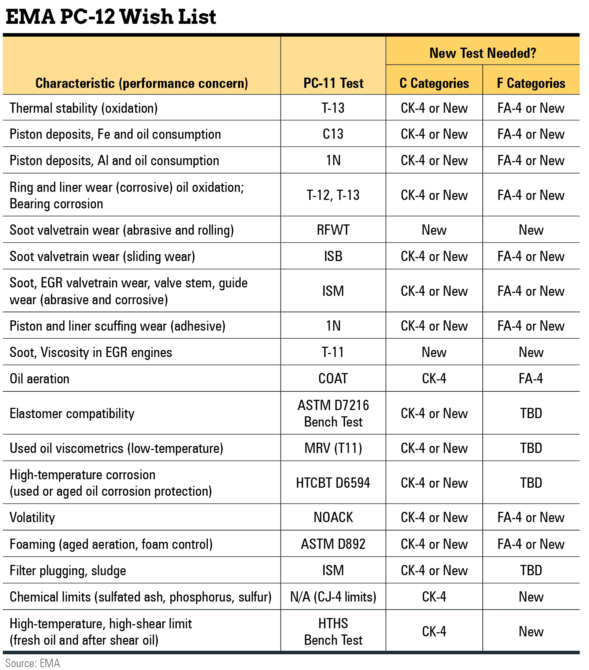Automotive
I’ve been in this business for a long time. For many years, the introduction of a new oil category was based on needs expressed by original equipment manufacturers and usually was the result of new engine technology or fuel standards. In 2002, the first heavy-duty oil category developed under the Engine Oil Licensing and Certification System became known as API CI-4. The process used to develop the new category was named Proposed Category 9. As far as earlier designations (PC-1 through PC-8) are concerned, I haven’t a clue as to why they were never discussed. The latest heavy-duty engine oil category, CK-4, began life as PC-11 and was introduced in 2017.
The next iteration of heavy-duty engine oils is on the drawing board. It’s going to be known as PC-12, but the title is not official until the decision is reached to develop it. For now, it is generically referred to as the request for new diesel engine oil category. We had a hint of what might be coming in late 2018 at the ASTM meeting held in Atlanta. Roger Gault from the Engine Manufacturers Association laid out a tentative timeline along with possible improvements that might be needed. He predicted that work might start in 2020 or 2021. He was right on the mark time-wise.
In early March, the Diesel Engine Oil Advisory Panel met virtually to review a letter from EMA that requested a new category. That is the start of the process, which consists of three phases. Phase 1 determines whether or not a request for a new category is merited. That’s the easy part. Phase 2 is the development of any necessary tests, new test limits, references and so forth. That’s the hard and very long part. Phase 3 basically dots the I’s and crosses the T’s. Not so long, but it can be tricky.
The EMA request sent to DEOAP Co-chairs Hind-Abi Akar of Caterpillar and Karin Haumann of Shell points out that there are regulations that will mandate more stringent NOx emission standards, extended emission warranty periods and extended regulatory useful-life mileage. The California Air Resources Board is proceeding with adopting more stringent regulations. The United States Environmental Protection Agency is beginning work on a rulemaking, too. Implementation of those regulatory changes are targeted to begin as early as model year 2027. EMA notes that engine lubricant performance can have a significant influence on the ability of new and existing engines to meet the more stringent regulatory requirements.
When the current category—CK-4 and FA-4—was developed, EMA requested that the category be split into two separate subcategories. Both were marked with corresponding high-temperature, high-shear viscosity performance levels. One preserves historical HDEO characteristics (diesel “C” category) at 3.5 megaPascals minimum, and one provides fuel efficiency benefits (diesel “F” category) at 2.9 to 3.2 mPa. EMA would like to see DEOAP keep this separation in the development of the proposed upgrade and also determine whether or not a greater distinction between the two subcategories is needed.
What sorts of changes does PC-12 suggest? I sat in on the March 2 meeting of DEOAP to listen to the conversation regarding PC-12. Let’s take a look at what we know so far and see where that leads us.
As with earlier engine oil categories, EMA wants to see improvements in oxidation stability and wear protection for both subcategories. The subcategories should also provide optimized soot dispersion. Aftertreatment protection should be evaluated to support the expected regulatory changes regarding extended useful-life requirements for engine and aftertreatment systems, too.
EMA goes on to say that current performance tests should be reviewed to ensure they reproduce the correct range of applications for each subcategory. For example, the F category hardware tests should use ultra-low-sulfur diesel fuel whenever possible. In addition, tests should represent soot levels that are typical of modern hardware. EMA wants to see backwards compatibility maintained for all C category characteristics except soot, but backward compatibility is not needed for the F subcategory.
So now the ball is in DEOAP’s court. Phase I has been implemented, which means that a new category evaluation team has been formed to review EMA’s request. The team is typically made up of representatives from API, EMA and the American Chemistry Council as well as liaison members. Its task is to determine whether or not a new category is warranted and what will be required for new tests or new limits on existing tests. It will also address such things as viscosity grades as well as physical and chemical limits. The NCET recommends to the API Lubricants Group the need, language, timing and funding mechanism for a new category.
|
Looking at the EMA letter, the “wish list” is long but also pretty generic. It also has some areas that could be in conflict with one another.
|
In the case of PC-12, recommended test work will focus on evaluating current CK-4 and FA-4 tests to see if they are suitable or perhaps need adjustments to test limits and test parameters. There is little or no actual test work in Phase 1 except what engine builders may have done to establish the need in the first place.
Looking at the EMA letter, the “wish list” is long but also pretty generic. It also has some areas that could be in conflict with one another. It looks to me like there are several tests that will need to be reworked with more stringent limits.
I mentioned that soot levels are of interest to EMA. If new oils are to be backward compatible, soot needs to be addressed. In fact, there are a number of tests that may be nearing their useful life for PC-12. This issue really needs some direction from the DEOAP on what categories or performance will be needed in the future.
Of particular interest to me is the global nature of the PC-12 proposal. There are proposed tests that seem to be measuring some of the same things on which European standards are focused. That’s natural, since there is a greater overlap in vehicles now than before. Italy’s Industrial Vehicles Corp. is one that stands out, as they are the most progressive in relation to viscosity. IVECO’s recommended viscosity is SAE 5W-20, which is quite a departure from the FA-4 viscosity of SAE 10W-30 with HTHS viscosity limits of 2.9 to 3.2 mPa.
EMA’s desire for improved oxidation and wear protection relates to improved metallurgy, which has helped reduce engine wear. This has allowed phosphorus levels to be lowered, even though the specification has been set at 0.12% maximum. In addition, the soot generated by modern ULSD-fueled engines has been substantially reduced.
An interesting side note to the international aspect of PC-12 is the fact that the best-selling oils are API CH-4 (20%). CH-4 is typically a 1.5% ash, 0.12% phosphorus product. One of the keystone features of the EOLCS system is that each category must be backwards compatible to earlier categories, so older engines can still get the protection they need. Hence, there may be a need to retain CH-4 (or maybe CI-4) to cover earlier categories. This reduction in soot levels in modern engines creates a quandary for the EMA proposal. CI-4-era engines typically generated soot levels of about 4% and along with their metallurgy led to increased wear. The soot tests for PC-12 will probably not be able to meet the needs of CI-4-type oil-engine combinations. If necessary, this will blow up the backwards compatibility directive.

Another issue is the incorporation of a wide range of duty cycles. Over-the-road trucks typically run at 40%-50% load factors and operate at much lower temperatures (30 degrees Fahrenheit to 40 °F) than off-road applications, where load factors are typically at 80%-90%. The differences between these two applications are immense. It almost begs the question of whether or not CI-4-type oils will continue to be required along with PC-12 products. Currently, most of the off-road engine manufacturers have their own oil, which is formulated to provide the necessary protection for tractors, earth-moving equipment and other applications.
The current CK-4 and FA-4 category calls for the Mack/Volvo T-12 test, which measures ring and liner wear. The T-12 has been nominated to continue in PC-12, probably at more restrictive limits. However, there is a problem with test parts availability. The T-12 was originally thought to be OK up to the introduction of PC-12. However, the test has shown high oil consumption, and there is likely to be only enough test availability to last until the end of 2021. There is no solution yet, but it’s being worked very hard. If the T-12 is included in PC-12, there will be a major push over the next five to six years to develop new formulations as well as establish new test parameters.
To add complexity, API invoked provisional licensing on March 17 because the ASTM D02.B02 Volvo/Mack Surveillance Panel said that independent labs could no longer run the Mack T-12 due to hardware problems. The provisional licensing will last until Sept. 17, and candidate oils must pass all other requirements in order to be licensed. They will then have to pass the T-12 in a timely manner once the test is back online.
A further confounding factor is the Ford 6.7L engine wear test. Ford has requested that a new category, CK-4 Plus, be introduced to accommodate this test. This process is similar to API SN Plus, which was introduced in 2019 to cover wear problems associated with phosphorus levels. Ford found that 0.08% phosphorus-containing oils could not protect this engine and specified a minimum phosphorus level of 0.10%. After much discussion, DEOAP declined to add the test as a supplement.
A final note is that the current EMA team is relatively new to this process. PC-11 was the work of a bunch of “old hands.” They understood the pitfalls that can derail the best plans and had learned through experience that negotiation and consensus are prerequisites for a successful category. I believe the new crew can do the same, but they may have to re-learn some of the lessons from the past. I guess there is nothing like starting out with a new API category.
Steve Swedberg is an industry consultant with over 40 years experience in lubricants, most notably with Pennzoil and Chevron Oronite. He is a longtime member of the American Chemical Society, ASTM International and SAE International, where he was chairman of Technical Committee 1 on automotive engine oils. He can be reached at steveswedberg@cox.net.
